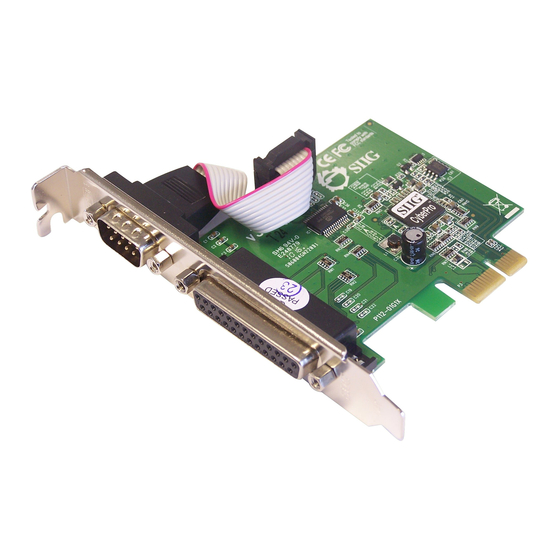
Table of Contents
Advertisement
Quick Links
Introducing the Cyber PCI I/O
The Cyber PCI I/O high-speed serial and parallel I/O card family
provides a complete solution for serial and parallel device
connections. It provides 16550/16650/16850 UART serial port(s)
which supports data transfer rates up to 920Kbps and ECP/EPP
parallel port(s) which supports data transfer rates up to 2MB/sec.
Since this installation guide is written for all Cyber PCI I/O boards,
some features on this installation guide might not be present on the
model you bought. Please only refer to the features that apply to
your board.
Features and Benefits
• Conforms to PCI v2.1 Plug and Play
• Full support for DOS- and Windows-based software
• Improves I/O access speed up to 8 times faster than existing
ISA-bus serial ports. Reduces CPU load and improves system
performance dramatically
• IRQ sharing feature eliminates IRQ conflicts
Serial interface:
• High-speed 16550/16650/16850 UART serial port (9-pin)
supports baud rates up to 920Kbps. Works with 56K V.90
external modems, ISDN terminal adapters, PDAs, digital
cameras, label printers and other serial port devices
• Built-in 16/32/128-byte FIFO buffers dramatically increase
data transmit/receive speed, especially under Windows
multitasking environment
Parallel interface:
• Conforms to IEEE 1284-1994 parallel port standard
• High-speed parallel port supports various types of parallel
port devices including removable cartridge drives, CD-R/
RWs, printers, SuperDisk
• Supports EPP, ECP(PIO mode), Bi-directional Parallel Port
(BPP) and Standard Parallel Port (SPP) modes
04-0201C
Cyber PCI I/O
Quick Installation Guide
TM
LS-120 drives, scanners and more
1
Advertisement
Table of Contents

Subscribe to Our Youtube Channel
Summary of Contents for SIIG Cyber PCI I/O
- Page 1 920Kbps and ECP/EPP parallel port(s) which supports data transfer rates up to 2MB/sec. Since this installation guide is written for all Cyber PCI I/O boards, some features on this installation guide might not be present on the model you bought.
-
Page 2: Hardware Installation
• Pentium or equivalent computer with an available 32-bit PCI slot • DOS/Windows 3.1x, Windows 95/98/98 SE/ME/NT 4.0/ 2000/XP Package Contents • One Cyber PCI I/O board • One floppy driver diskette • One 5-year warranty card • This quick installation guide Hardware Installation General instructions for installing the card are provided below, since the design of computer cases and motherboards vary. -
Page 3: Software Installation
Software Installation This section provides information on how to install the Cyber PCI I/O's drivers for the following operating systems: Windows 95/98/98 SE/ME Windows NT 4.0 Windows 2000/XP DOS/Windows 3.1x Windows 95 Driver Installation 1. At the Add New Hardware Wizard window, click Next. - Page 4 Windows and click Finish. To verify successful installation in Windows NT 4.0: 1. Go to Start / Setting / Control Panel, double click SIIG Cyber PCI 20X device icon. 2. New COM port address and LPT number will be assigned for the ports when successfully installed.
- Page 5 Windows 2000 will automatically detect and install the correct driver for the CyberSerial PCI and CyberParallel PCI boards. For the rest of the Cyber PCI I/O boards, please follow the instructions below: 1. At the New Hardware Wizard, click Next.
-
Page 6: Troubleshooting
To verify successful installation in Windows XP: 1. Right click My Computer, click Manage, then select Device Manager. 2. Click on the + (plus sign) in front of Ports (Com & LPT). 3. New Cyber port(s) should be listed. DOS/Windows 3.1x Driver Installation 1. -
Page 7: Technical Support
RMA number posted on the outside of the shipping carton. Step 3: Ship the Product You are responsible for the cost of shipping back to SIIG at the following address: SIIG, Inc. - Page 8 6078 Stewart Ave. Fremont, CA 94538-3152 SIIG and SIIG logo are registered trademarks of SIIG, Inc. Microsoft, Windows and Windows NT are registered trademarks of Microsoft Corporation. Pentium is a registered trademark of Intel Corporation. Other names used in publication are for identification only and may be trademarks of their respective companies.









Need help?
Do you have a question about the Cyber PCI I/O and is the answer not in the manual?
Questions and answers